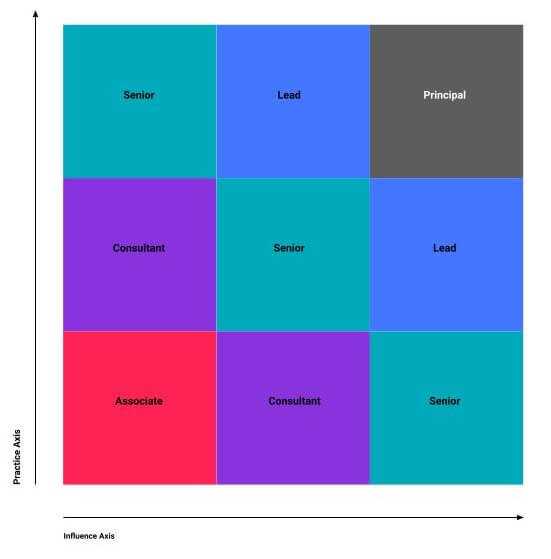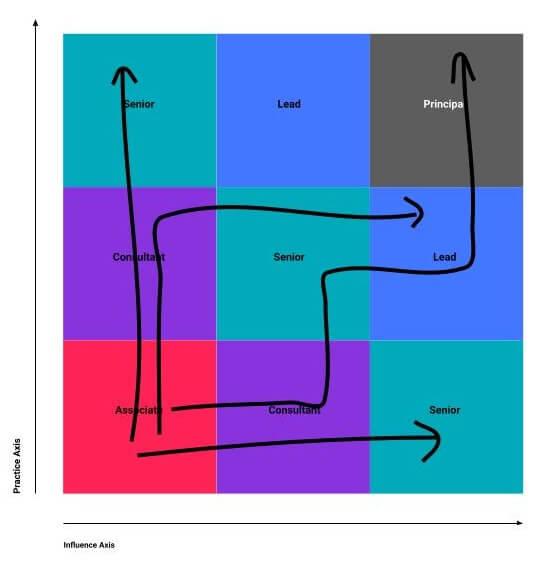Before I joined TXI about five years ago, I’d spent most of my career in education. I care deeply about learning and growth opportunities, and there’s a large body of research that indicates that personalized learning with qualified educators leads to better outcomes. So when I decided to make some significant enhancements to how TXI supports its people, I knew I wanted to incorporate those two elements: diverse growth paths for individuals to choose from, no matter their starting point, and expert training for the managers who would be supporting them on those paths.
Before this effort, TXI had a linear level model--effectively, a “ladder”. There was one way to grow, straight up a predetermined path. The structure implied that all people at the same level needed to focus on the same kinds of work, and deliver the same kinds of value--that they were all, in a sense, the same. It wasn’t true, of course, but it did impact people’s reality: it was how we set expectations, evaluate outcomes, and define titles and compensation.
TXI Career Grid
In partnership with our long-time advisor Claudia Richman, we transformed our ladder into a grid (yes, a grid is just a mashup of two ladders, but bear with me…). One axis of the grid describes your skill in your primary practice (delivery, design, or engineering), and the other describes your organizational and influencing skills (think: facilitation, mentorship, or inclusion). Behind each axis is a series of descriptions of the behaviors and outcomes a person is expected to regularly demonstrate at each level. At least once a year, every individual does an evaluation with their manager for their skills across each axis, and the intersection of their skills points to their level. Individuals and managers use their own points of view and gather both formal and ad hoc feedback from colleagues as evidence for determining the right placement.

Image description: TXI’s career grid, with the x-axis labeled “Influence” and the y-axis labeled “Practice Skills”. Within the grid, itself are smaller squares noting the placement of Associate, Consultant, Senior, Lead, and Principal levels.

Image description: TXI’s career grid shows arrows illustrating flexible growth paths that can be vertical, horizontal, or anywhere between.
The career grid isn’t revolutionary, but what it makes possible is a more explicit choice in how your career grows. It makes clear that a person can focus more on their practice, more on influence, or a balance of the two, and each of those focuses drives different but equal value. That’s why you see multiple squares for consultant, senior, and lead in the image. People who fall within each of those squares have the same title, drive similar value, and are paid within the same salary band. And no choice cuts you off from making different, future choices. A person might dive into their practice skills at first, then have an engagement that makes them want to dig deeper into their organizational influence skills, and later get re-energized by a new technical framework and shift their focus again. You don’t ever need to “declare a major”, so to speak. As long as you’re meeting the expectations TXI has of its people and doing work that feels engaging and energizing to you, you’re on the right path.
Benefits
The benefits of this approach are pretty obvious to the individual--they get to learn and grow in ways that are exciting to them and valuable to their careers. The benefits to TXI as a company are also significant: When our consultants bring broader skills to their client engagements, they drive greater value for those clients and achieve better outcomes. We predict that people who are excited about their growth will also stay longer. TXI already has a pretty long average tenure, with multiple folks who’ve been here more than a decade, but we have noticed in the past that when people at more senior levels leave, it tends to be for specific growth opportunities that are harder to come by at a smaller company. By offering more diverse career paths, people now stay here longer without feeling like they’re stalling out.
“Managers are champions and advocates for their team members, helping them grow and reach new levels in their professional careers. We finally have a role with the right combination of responsibility and access to make sure that folks are getting the support they need.” ~ Andrew Horner, Engineering Manager
Along with the career grid, we now have more clear and equitable forms of support. Every TXIer has a manager and a Head of Practice to help them reflect on their current work, consider where they want to grow next, and support them in achieving that growth.
Training
Although some of our new managers have experience with similar roles at previous organizations, we wanted to make sure that everyone was starting with a common vocabulary, lens, and expectations of what it means to be a TXI manager. So again we called on Claudia to provide training to the managers in a cohort model. We met weekly for about two months, working through a combination of presentations, readings, videos, and a lot of small-group discussions, on topics ranging from how best to manage your time, to how to deliver challenging feedback, to how to root out bias and support all your people equitably.
“As a new manager, I appreciated the opportunity to train in small cohorts and the ability to role-play in a safe space. It prepared us in ways that went beyond what a static textbook could offer. The real-world scenarios provided us with tools to handle challenging conversations and manage with empathy.” ~ Benedict Wong, Product Delivery Manager
In essence, our implementation of the career grid and our transformation into a manager-supported organization are both promises that TXI is making to TXIers. We set explicit expectations of a person at a given level and with a specific focus, we provide opportunities to learn and grow along diverse career paths, and we provide the individualized support and meaningful feedback needed to achieve those things.




